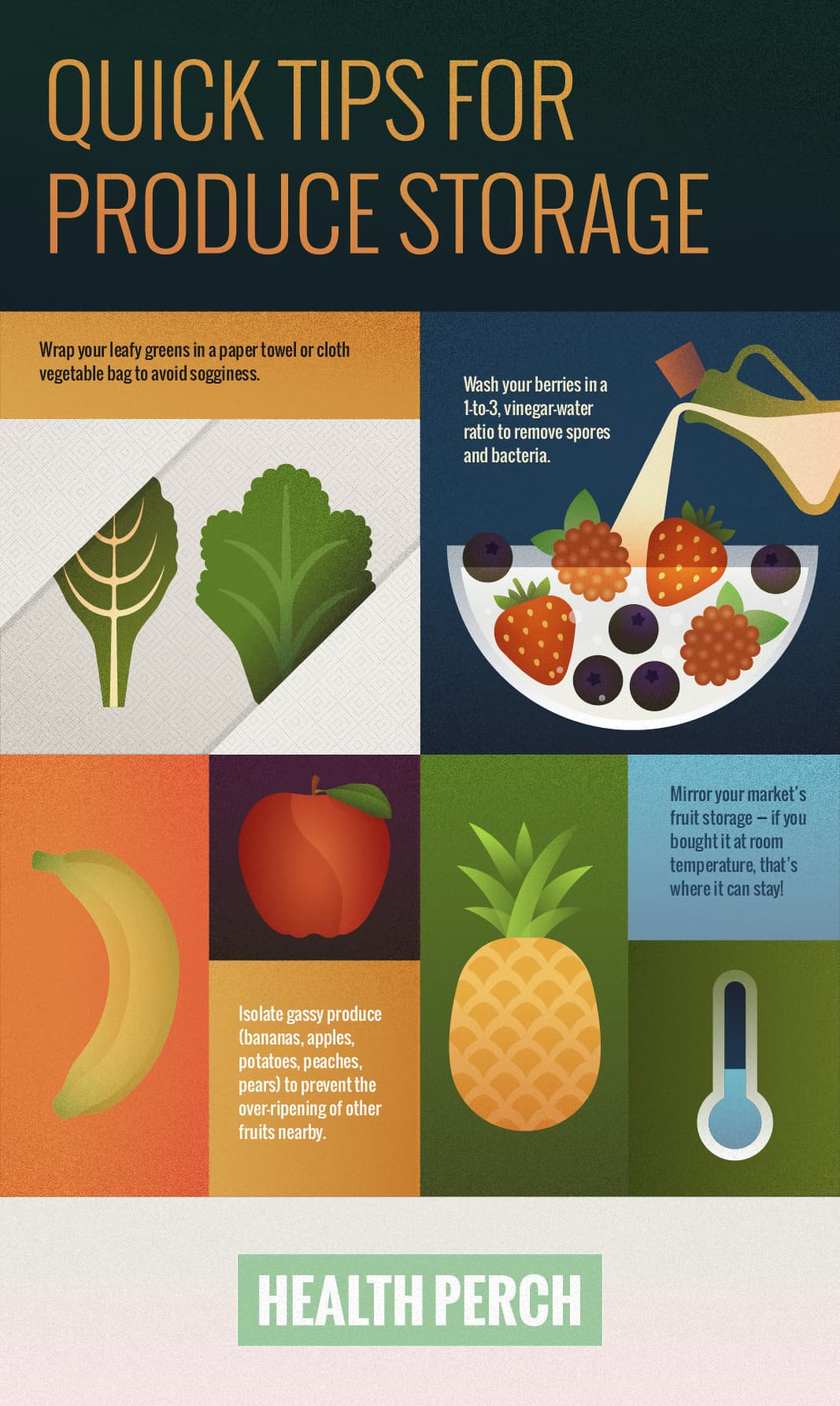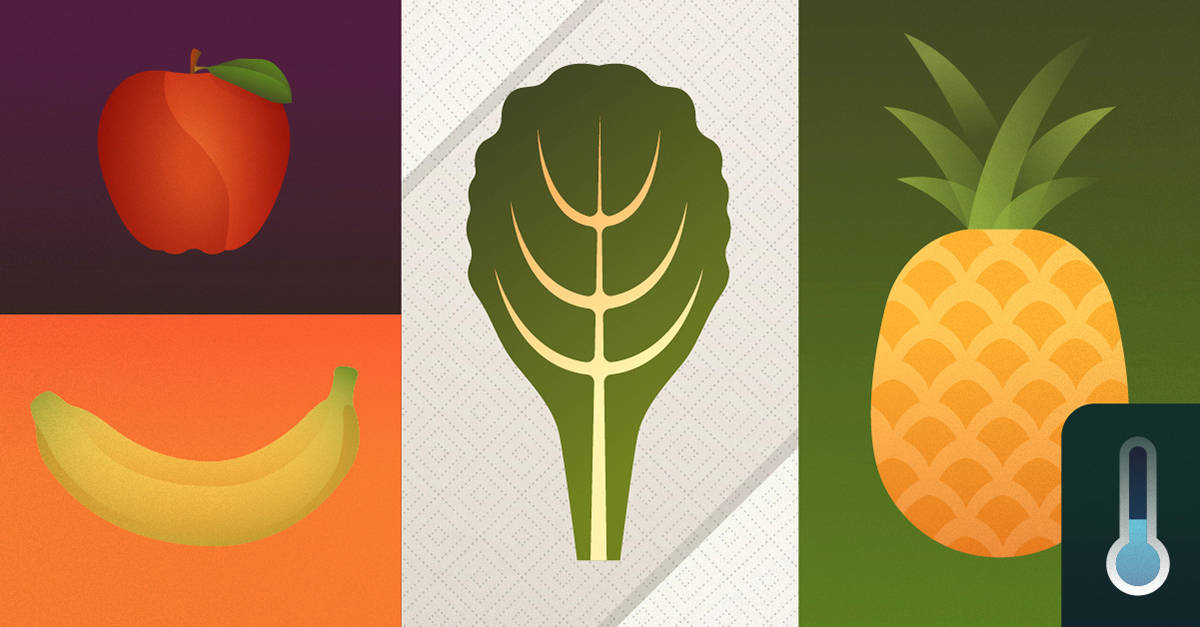How many days a week do you typically “eat the rainbow”? After all, a diet filled with a variety of fresh fruits and vegetables doesn’t just ensure a pretty plate — it’s a key component of good health.
Even though many of us try to stop by the farmers market or shop the perimeter of our local grocery store to have those colorful fresh fruits and veggies on hand at home, life tends to get in the way. All too often, that gorgeous curly kale or those juicy strawberries we were so excited to snack on have gone squishy, brown, moldy, or worse. With rotten produce in hand, we feel bad about all the nutrition we’ve missed out on, and we’re essentially tossing money straight into the compost pile.
Fortunately, there are some handy tips and tricks for giving your produce a little longer shelf life once you’ve brought it home. But, before we dive into the how, let’s talk about why a diet rich in fresh fruits and veggies is so darn important.
Why Adding More Veggies and Fruit to Your Diet Is a Smart Move
In an entirely unsurprising nutshell, fruits and veggies are good for you! In a study published in 2021, researchers observed over 100,000 women and men over a 30-year span. They assessed the subjects’ diets at baseline (at which point all participants were free of cardiovascular disease, cancer, and diabetes) and subsequently every two to four years. The results? Higher consumption of most subgroups of fruits and vegetables were clearly linked with lower mortality.
And that’s not all. When the Harvard T.H. Chan School of Public Health reviewed the research on produce intake, they found that a fruit- and veg-heavy diet did even more for people, offering benefits like:
- Lowering blood pressure
- Reducing the risk of heart disease and stroke
- Preventing some types of cancer
- Lowering risk of eye and digestive problems
- Having a positive effect on blood sugar
Now that you’ve seen why eating your fruits and veggies is so necessary, let’s take a look at how to make that fresh produce last.
How To Make Your Produce Last Longer
Who among us hasn’t had a bunch of bananas go from perfectly ripe to practically rotten overnight? And when it comes to avocados, well, sometimes it seems like you could blink and miss that magical moment between not-quite-ripe and brown mush. Certain kitchen staples are just notorious for spoiling quickly, but with a few tricks, you can keep many of them around for a few days longer.
Storage Solutions
Not all produce should be stored the same way, so before you just toss it all in the crisper together, take note of what you’ve got, how it should be stored, and whether it should be separated from other items in your shopping bag.
- Reduce excess liquid for certain fruits and veggies. Many types of produce, like lettuce, give off moisture when they sit for a while, and that can increase their speed of spoilage. To slow down that process, try wrapping your leafy greens in a paper towel or cloth vegetable bag; even just placing a paper towel in the container holding your greens can help prevent a buildup of moisture.
- For other produce, use water to help them stay fresh. Hardy vegetables, like celery and carrots, can be cut into snack sizes and stored in a bowl of water to help them stay crispy. And for more delicate produce, like berries, washing them in a solution of one cup vinegar and three cups of water can help remove the icky stuff, like spores and bacteria, that can cause them to spoil more quickly. Just be sure to wash them well with clean water and pat them fully dry before placing them back in the fridge.
- Identify and isolate “gassy produce.” You might not smell it, but bananas, apples, potatoes, peaches, pears, and other produce give off gases such as ethylene while ripening, which affect other produce (including cucumbers and berries) and make them age prematurely, so it’s best to store them separately if you can. Unless you want to ripen something quickly, that is — in that case, let them get cozy!
- Keep it cool. Many fruits and vegetables do well in the refrigerator with a temperature of 40 degrees Fahrenheit or less, but there are plenty of others, like bananas, that need to be stored at room temperature. Not sure what to do? Take note of how they’re stored at the grocery store; cold produce should generally be refrigerated, and if you’re unclear on the others, a short search for your particular produce should yield a quick answer. It’s also worth noting that some produce that doesn’t ripen well in the fridge, like avocados, can be transferred to the fridge once they reach peak ripeness to give you a day or two to use them up.

Plan for Perfection
One of the best ways to reduce wasted produce is to do your meal planning ahead of time and shop accordingly. After all, if you’re shopping on Sunday, but won’t have a chance to make that stir-fry until Thursday, it makes sense to pick produce that’s a little under-ripe, if possible, so it’ll be perfect when you want to use it.
Another meal prep tip is to plan a few meals for the week using the same types of vegetables so you can easily go through everything you bought.
And, if you open your veg drawer and see that your spinach is on the verge of turning slimy, don’t toss it — freeze it! In fact, there are plenty of produce that can benefit from a deep freeze. You can cut and peel ripe fruit, then freeze on a parchment-lined tray in a single layer, transferring to a freezer bag once frozen, and for other veggies, consider chopping and blanching them before freezing. You’ll have plenty of produce for soups, stews, smoothies, and more!
Conclusion
With a little planning and some know-how, you’ll soon find that you’re far better equipped at buying that wonderful, fresh produce, without leaving any stragglers to waste away in your fridge.
No longer will you lament squishy fruits and vegetables. Venture to the grocery store or the farmers market with confidence. There’s lots of yummy food (and great health benefits) to be had.
